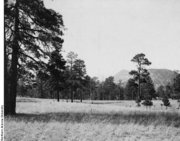Beyond Old Growth: Chapter 3
| Topics: |
Why are older forests important?
Although the older forests of the five regions addressed by the NCSSF-sponsored workshops are very different from each other in composition, character, and other respects, they share many common values that make them important. Two values that clearly emerged from all five workshops were the essential role of older forests in maintaining biodiversity and some less tangible but important aesthetic and spiritual benefits that they provide to society.
Contents
Biodiversity
The findings of all five workshops emphasized the importance of older forests in maintaining biodiversity. Here are some examples:
- In the Northeast, some lichens, mosses, fungi, invertebrates (animals without backbones), and other species that depend on older forests are threatened by climate change because they disperse poorly. As their habitats shift northward in response to a warming climate, a system of corridors and stepping-stones (patches of favorable habitat in a fragmented forest landscape) of older forest could conserve forest biodiversity by providing migration routes for these species.
- Although the older forests of the Great Lakes region are very different from those that were there before the region was intensively cut over in the late 19th and early 20th centuries, the findings of the Great Lakes workshop defined the ultimate goal of forest conservation as sustaining ecologically complex older forests with a broad range of habitat types across the region.
- The longleaf pine woodlands of the Southeast clearly illustrate the importance of older forests in sustaining native species. Mature longleaf pine forests that have been frequently burned (Fire in America) over long periods are the preferred habitat of many species of concern (in danger of extinction, threatened with endangerment, or rare in the landscape) in the southeastern coastal plains. Bottomland hardwood forests also are important.
- In the Pacific Northwest, older forests provide habitat for many organisms, some of which show a preference for old-growth conditions compared with other stand development stages, the most famous of which is the northern spotted owl.
- In the Southwest, older forest helps to sustain the ponderosa pine ecosystem—its structure, processes, composition, and food-chain interactions—at a variety of scales. Older trees may be particularly important because they have survived centuries of environmental and biotic fluctuations, and their seeds and pollen may make critical contributions to genetic diversity. Under natural conditions, a biologically rich understory (the community of smaller plants that grows in the shade of the crowns of large trees) develops in diverse habitats in many older ponderosa forests—near clumps of big trees, in small openings between clumps, and in open meadows and parks. Frequent low-intensity fire is a key element in maintaining this ecosystem.
Societal values
Societal values drive many public debates about old growth. Ecological and biodiversity concerns are secondary for many people who just don’t want large, old trees to be cut down.
Surveys conducted in the Northeast indicate that the general public values older forests and wilderness areas and wants them maintained. Older forests of the Southeast offer many benefits to the people of the region beyond sustaining much of the diversity of plant and animal species. They also provide a link to the region’s history through the piney woods and bottomland forests that provided resources to sustain the first European settlers. The aesthetic qualities of large “cathedral-like” stands of trees connect today’s residents of the Southeast to their past.
The Pacific Northwest has a greater area of older forest than any other temperate-zone region on earth, and it has seen many heated policy and public debates about old growth over the past 25 years. The economic and social value of older forests in the region was clearly demonstrated when President Clinton convened a Forest Summit in 1993 to find solutions to controversies over logging old-growth timber on public lands. This summit led to the Northwest Forest Plan, designed to protect millions of acres of old growth on federal lands from logging. The high social value placed on older forests in this region grows from recognition of the recreational and aesthetic opportunities that they offer as well as their ecological importance.
Research on people’s views of forests in the Southwest has affirmed the aesthetic value of older forests. One study concluded that many people prefer open, park-like old-growth ponderosa pine forests similar to those of pre-European settlement to denser forests with smaller trees. Another study recommended that large, mature trees should be retained in forest thinning projects because they are an important part of scenic beauty.
Carbon sequestration and other ecological services
In all five regions, healthy forests in general and older forests in particular provide many useful ecological services to society—benefits to households, communities, and economies such as maintaining clean air and water and enriching soils.
Forests play an important role in global climate change by absorbing atmospheric carbon dioxide and sequestering, or storing, carbon. Older forests contain large quantities of organic matter in living and dead trees, other vegetation, and soils and are thus larger reservoirs of sequestered carbon than younger forests. This is an ecological service that is a special attribute of older forests.
Older forests improve soil quality. As they decay, fallen trees slowly release nutrients that continually enrich soils, allowing them to support more diverse ecological communities. Some large, dead trees fall into streams, creating pools and cascades that provide favorable habitats for many aquatic plant and animal species. These logs also release nutrients into the water, help keep the stream water clean by capturing debris, and reduce the impacts of floods. Water that runs off from older forests is of high quality and is valuable for wildlife and human consumption.
|
|
.jpg)

.jpg)